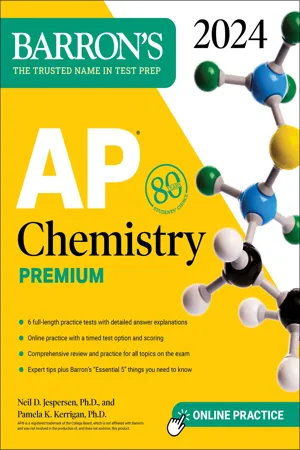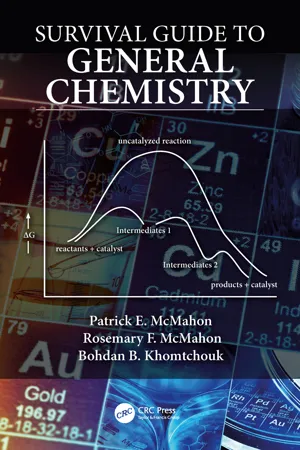Chemistry
Intermolecular Forces
Intermolecular forces are the attractive or repulsive forces between molecules. These forces play a crucial role in determining the physical properties of substances, such as boiling and melting points, viscosity, and solubility. The main types of intermolecular forces include London dispersion forces, dipole-dipole interactions, and hydrogen bonding.
Written by Perlego with AI-assistance
Related key terms
Related key terms
1 of 4
Related key terms
1 of 3
10 Key excerpts on "Intermolecular Forces"
- No longer available |Learn more
- Neil D. Jespersen, Pamela Kerrigan(Authors)
- 2023(Publication Date)
- Barrons Educational Services(Publisher)
The attraction between the partial positive end of one dipole and the partial negative end of another dipolar molecule. The molecules can be the same or different substances.Hydrogen bondingVery strong dipole-dipole attractive forces observed exclusively in compounds that have an F, N, or O bonded directly to a hydrogen atom.Note that some chemists combine all of the above forces under the general term van der Waals forces. These forces can be estimated using Coulomb’s law.Physical Properties of Liquids
We may use the forces discussed above to describe the liquid state. Some of the physical properties of liquids are surface tension, viscosity, evaporation, vapor pressure, boiling point, and heat of vaporization.Surface Tension
Surface tension is due to an increase in the attractive forces between molecules at the surface of a liquid compared to the forces between molecules in the center, or bulk, of the liquid. This property causes fluids to minimize their surface areas. As a result, small droplets of liquids tend to form spheres. Surface tension produces a “skin” on a liquid surface that allows small insects to literally stand on water. Also, carefully placed small iron objects such as needles and pins can float on the surface of water even though iron is almost eight times as dense as water.When considering surface tension, we first look at a molecule of the liquid in the interior of the sample (the bulk solvent). In the interior, the solvent molecule is surrounded by other solvent molecules on all sides as shown in Figure 7.7a . At the interface between the liquid and the gas phase, some of the molecules surrounding the solvent have been removed as in Figure 7.7b - No longer available |Learn more
- Steven Boone, Drew H. Wolfe(Authors)
- 2011(Publication Date)
- Collins Reference(Publisher)
CHAPTER 12Liquids and Solids
L iquids and solids are the condensed phases of matter. Their properties are very different from those of gases because of the attractive forces between particles of which they are composed. To begin our study of liquids and solids, we will consider the Intermolecular Forces in liquids.12.1 Intermolecular Forces IN LIQUIDSIntermolecular Forces are the attractive forces that bind particles in the liquid state. The three principal Intermolecular Forces found among the particles in the liquid state are dipole-dipole interactions, hydrogen bonds, and London dispersion forces.Dipole-Dipole InteractionsDipole-dipole interactions are found in most liquids composed of polar covalent molecules. As one polar molecule approaches another, the partial negative end of one attracts the partial negative end of the other. In liquids, the more positive ends of molecules align with the more negative ends of other molecules. However, at room conditions (298 K and 1 atm), an orderly regular pattern does not exist because the kinetic energies of the molecules are too large relative to the energy of attraction to keep the molecules fixed in such an arrangement.Dipole-dipole interactions are rather weak forces. Two principal factors contribute to their weakness: the small partial charges in polar covalent molecules and the short range of the dipole-dipole interactions. The energy of interaction (the potential energy) of two ions depends on the magnitude of the charges (q 1 and q 2 ) and the distance, d , which separates them.For dipole-dipole interactions the values of q are small compared to the full positive and negative charges on ions. Unlike positive and negative ions in which the attractive energy is proportional to 1/d , the attractive energy for dipole-dipole interactions is proportional to 1/d 6 for polar rotating molecules (1/d 3 - eBook - ePub
- Andrea R. Tao(Author)
- 2023(Publication Date)
- Wiley-VCH(Publisher)
Intermolecular forces are responsible for these “weak” or secondary bonds that occur between molecules, particles, and surfaces. The bonds that result from Intermolecular Forces lack specificity, stoichiometry, and directionality. These forces can also result in interactions that occur over long distances – much longer than interatomic bond lengths.As we will see throughout Chapter 1 , Intermolecular Forces play an important role in dictating materials and molecular behavior at the nanoscale. We will cover five different types of Intermolecular Forces: electrostatic, hydrogen bonding, van der Waals (vdW ), hydrophobic, and steric forces. For each of these, we will derive and discuss their universal force laws. We will also discuss the differences between these forces for molecules versus nanoscale objects. Finally, we will develop an understanding of how potential energy diagrams can be used to predict the overall intermolecular interactions between two objects as a function of separation distance. This knowledge will be applied toward understanding the behavior of nanosystems ranging from atoms and molecules (e.g. DNA and polymers) to particles and other nanomaterials (e.g. liposomes, metal nanoparticles, C60 ).1.1 The Pairwise Potential
Intermolecular Forces can lead to attraction or repulsion between atoms, molecules, particles, and surfaces, and contribute significantly to how nanoscale materials and systems behave. These forces are classified as conservative forces, meaning that they satisfy the relationship:(1.1)where F is the force, V(r) is the potential energy of the object, and r is distance. Because of this relationship, potential energy can be used as a descriptor of whether the force between two objects is attractive or repulsive.We often consider pairwise potentials that describe V(r) as a function of separation distance to determine attraction or repulsion. For example, two possible pairwise potentials between two spherical particles of radius Rsare depicted in Figure 1.2 - eBook - ePub
- Hans-Jürgen Butt, Karlheinz Graf, Michael Kappl(Authors)
- 2023(Publication Date)
- Wiley-VCH(Publisher)
Introductions to surface forces include [ 7, 174, 175 ]. Van der Waals forces are discussed comprehensively in [ 176 ]. 5.1 Van der Waals Forces Between Molecules Forces between macroscopic objects result from a complex interplay of the interaction between molecules in the two objects and the medium separating them. The basis for an understanding of Intermolecular Forces is the Coulomb 1 force. The Coulomb force is the electrostatic force between two charges and : (5.1) If the two charges are in a medium, the permittivity is higher than one, and the electrostatic force is reduced accordingly. The potential energy between two electrical charges that are a distance apart is (5.2) For charges with opposite signs, the potential energy is negative. They reduce their energy when they get closer. Example 5.1 The potential energy between and, being 1 nm apart, in a vacuum is This is 56 times higher than the thermal energy at room temperature. Most molecules are not charged. Still, the electric charge is often not distributed evenly. A molecule can have a more negative side and a more positive side. In carbon monoxide, for example, the oxygen is more negative than the carbon atom. To first order, the electric properties of such molecules are described by the so‐called “dipole moment”. For the simple case of two opposite charges and that are a distance apart, the dipole moment is given by. It is given in units of Coulomb meters. Often, the old unit Debye is used. One Debye is equal to a positive unit charge and a negative unit charge that are 0.21 apart; it is denoted by C m. The dipole moment is a vector that points from minus to plus. If we have more than two charges, we must integrate the charge density over the whole volume of the molecule, which leads to the general definition of the dipole moment: (5.3) Let us now return to intermolecular interactions - eBook - ePub
Pharmaceutical Dosage Forms and Drug Delivery
Revised and Expanded
- Ram I. Mahato, Ajit S. Narang(Authors)
- 2017(Publication Date)
- CRC Press(Publisher)
A liquid or a solid phase can be defined as a conglomeration of like molecules, held together by intermolecular bonds that hold the molecules in association and proximity with each other. The two phases—liquid and solid—differ in the degree of order in the association of the molecules, with the solid phase being more ordered than the liquid phase. Within the solid phase, the crystalline phases are more ordered than the amorphous phases. The gas phase, on the other hand, is the least ordered, with the molecules undergoing random Brownian motion, independent of other molecules.The bonds that hold a phase together are van der Waals force, ionic, dipole, and hydrogen bonds—depending on the atomic structure of the molecules of a phase. For example, water molecules are held together predominantly by hydrogen bond and dipole forces, whereas octane molecules are held together by weak van der Waals forces. The strength of Intermolecular Forces of attraction and the proximity of the molecules follow the general trend: solids > liquids > gases. In the bulk of a phase, a molecule is surrounded by other molecules of the same type and encounters similar forces in all directions, which tend to neutralize each other. At the interface, a molecule encounters directionally different forces (Figure 8.1 ). Forces of attraction between the molecules of the same type within a phase can be termed cohesive forces, and the resulting phenomenon is termed cohesion . Similarly, forces between the molecules of different types at the interface can be termed adhesive forces , and the resulting phenomenon is termed adhesion .At the liquid–gas interface, cohesive forces are generally greater than adhesive forces, leading to an inward pull on the molecules toward the bulk. This force pulls and keeps the molecules of the interface together and tends to contract the surface, resulting in minimization of the exposed surface area. Thus, a liquid droplet tends to be spherical, since this shape can contain the maximum volume per unit surface area. Expansion of surface requires application of force. This force can be expressed in terms of surface or interfacial tension. - eBook - ePub
- Patrick E. McMahon, Rosemary McMahon, Bohdan Khomtchouk(Authors)
- 2019(Publication Date)
- CRC Press(Publisher)
21 Guideline for Analyzing Intermolecular Forces and Calculating Phase Change Enthalpies I OVERVIEW OF INTERPARTICLE AND Intermolecular Forces Interparticle forces are the forces of attraction between atoms, ions, or molecules that hold bulk matter together. Ionic compounds do not exist in individual molecules but as extended three-dimensional arrays of ions held together by ionic forces ; these are the same electromagnetic forces of attraction that hold any individual positive and negative ions together. Ionic forces are extremely strong; ionic compounds are all solids at 25°C and have very high melting points. Metals in the elemental form are extended three-dimensional arrays of metal atoms held together by metallic bonds. The metallic bond is formed by the overlap of many individual metal atomic orbitals producing very extended molecular orbitals, “delocalized” orbitals. Network covalent compounds are extended three-dimensional arrays of atoms held together by covalent bonds. The structure can be completely covalent; examples are diamond (carbon solid) or quartz/glass (SiO 2). The structure may also be a “hybrid” of large covalent sections partially held together by other Intermolecular Forces; an example is graphite, another form of solid carbon. Molecular covalent compounds exist in the form of discrete molecules. Individual molecules are formed through covalent bonding between the atoms in one molecule. However, discrete individual molecules cannot be covalently bonded to each other to assemble into larger amounts of matter. In this case, large amounts of molecular matter must be held together through non-covalent attractive forces termed Intermolecular Forces - eBook - ePub
- Atsushi Ikai(Author)
- 2016(Publication Date)
- Elsevier(Publisher)
Chapter FourInteraction Forces
A. Ikai Tokyo Institute of Technology, Yokohama, JapanAbstract
Molecules, whether biological or synthetic, attract or repel each other, in other words, interact with each other. All kinds of interaction observed in the biological world are based on electrostatics. The essence is, charges of the same signs repel and opposite charges attract each other. In practice, such interactions are classified according to the distribution of electrons within the atoms or molecules in focus. Ions are fully charged, negatively or positively, but uncharged neutral molecules can be either polar or nonpolar depending on the relative positions of negative and positive charge distributions. Polar molecules have a dipole moment. Hydrogen bonds are important in biology because it is a relatively strong interaction between two electronegative atoms having a hydrogen atom in between. Electronegativity is a measure of the tendency of each nucleus in a molecule to attract valence electrons to its side. Other forms of noncovalent interactions are introduced under different conventional names.Keywords
Covalent bond; Dipole moment; Dispersion force; Electrostatic interaction; Hydrogen bond; Hydrophobic interaction; Lenard-Jones potential; Non-covalent bondContents4.1 Covalent Versus Noncovalent Bonds 4.2 Basics of Electrostatic Interaction 4.3 Various Types of Noncovalent Interactions 4.3.1 Charge–Charge Interaction 4.3.2 Charge (Ion)–Dipole Interaction 4.3.3 Dipole–Dipole Interaction 4.3.4 Dipole–Induced Dipole Interaction 4.3.5 Dispersion Interaction 4.3.6 Hydrogen-Bonding Interaction 4.3.7 Hydrophobic Interaction 4.4 Application of External Force 4.5 Interaction Force Between Macromolecules 4.5.1 Exclusion Effect 4.5.2 Depletion Effect 4.6 Water at the Interface Bibliography4.1. Covalent Versus Noncovalent Bonds
- eBook - ePub
- Jacob N. Israelachvili(Author)
- 2010(Publication Date)
- Academic Press(Publisher)
Weak but ubiquitous body force. Force can change sign at some finite distance. Electrostatic (Ch. 14) Coulomb, ionic, salt-bridge, dipolar, hydrogen-bonding, charge-transfer (harpooning), double-layerb . Either: repulsive between like charges, attractive between electro-neutral systems Strong, long-ranged force arising in polar solvents. Usually a surface force. Solvation (Ch. 15) Structural, epitaxial, hydration (in water), depletionb , hydrophobicc . Either, including oscillatory Surface force that modifies the local liquid structure. Entropic (Ch. 16) Steric, osmotic, thermal fluctuation/undulation/protrusion, polymer bridging, depletionb , double-layerb . Usually repulsive Surface force that arises from the confinement of solvent or solute molecules between the surfaces. Short-range physical (Ch. 17, 19) Adhesive, cohesive, surface tension, wetting, capillary. Usually attractive Can be either a body or surface force Short range chemical (Ch. 3) Covalent, quantum mechanical, metallic, exchange, steric, hard core, Born. Either: ultimately repulsive at small distances Strong short-ranged surface forces, largely independent of the suspending liquid medium. Specific (Ch. 21) Complementary (electrostatic or geometric), host-guest, lock-and-key, ligand-receptor, antibody-antigen. Attractive (specific but not necessarily strong) Single or multiple noncovalent bond arising from perfect fit of ion or molecule into host pocket or lattice site. Main “recognition” interaction of biological molecules. Nonequilibrium (Ch. 9, 18, 22) Viscous (drag), friction, shear, lubrication, hydrodynamic, energy dissipating, hysteretic. Either (depends on externally applied forces) Involves continuous or transient motion of molecules or particles. Heat generating. a - eBook - ePub
Chemistry
Concepts and Problems, A Self-Teaching Guide
- Richard Post, Chad Snyder, Clifford C. Houk(Authors)
- 2020(Publication Date)
- Jossey-Bass(Publisher)
intermolecular attractive forces cause the molecules to stick together and coalesce into a liquid. The intermolecular attractions affect the flow rate of a liquid. Heavy oils, syrup, and molasses flow more slowly than water or gasoline. Compared to liquids that flow rather quickly, liquids of slower flow rate would have (stronger, weaker) __________ intermolecular attractive forces.Answer: stronger (The stronger the intermolecular attraction, the more the molecules stick to each other and the slower the flow rate of a liquid.)The viscosity of a liquid refers to its resistance to flow. A liquid with a high resistance to flow such as heavy oils or molasses would exhibit high viscosity. A liquid with very little resistance to flow would exhibit low viscosity. High viscosity is associated with relatively (strong, weak) __________ intermolecular attractive forces.Answer: strongA liquid with relatively weak Intermolecular Forces would probably exhibit low __________ (use the term that refers to resistance to flow).Answer: viscosityRazor blades and certain insects that are heavier than water can float on top of the water due to surface tension. Remember that the molecules of a liquid attract each other through intermolecular attractive forces. Surface tension is caused by a difference in direction of intermolecular attractive forces between those molecules at the surface of a liquid and those in the body of the liquid.A molecule in the body of the liquid (molecule B) is surrounded by attraction from other liquid molecules. There is equal attraction from all sides. A molecule at the surface of the liquid (molecule A) is attracted only toward the interior of the liquid. It is not balanced by an attraction from above. Which molecule (A or B) is involved in surface tension? _________________ - Paul C. Hiemenz, Raj Rajagopalan, Paul C. Hiemenz, Raj Rajagopalan(Authors)
- 2016(Publication Date)
- CRC Press(Publisher)
Intermodular and Surface Forces, 2d ed., Academic Press, New York, 1991. (Graduate and undergraduate levels. An excellent source for the relation between molecular-level van der Waals interactions and macroscopic properties and phenomena such as surface tension, cohesive energies of materials, adhesion, and wetting. Also discusses direct measurement of van der Waals forces using the surface force apparatus.)Lyklema, J., Fundamentals of Interface and Colloid Science: Volume I. Fundamentals, Academic Press, London, 1991. (A graduate-level treatment of the topics discussed in this chapter.)Mahanty, J., and Ninham, B. W., Dispersion Forces, Academic Press, New York, 1976. (An advanced monograph on dispersion forces. Discusses topics such as London and Lifshitz theories.)Ross, S., and Morrison, I. D., Colloidal Systems and Interfaces, Wiley, New York, 1988. (Undergraduate level. A textbook on colloids with Hamaker constant data for more materials than given in this chapter.)Verwey, E. J. W., and Overbeek, J. Th. G., Theory of the Stability of Lyophobic Colloids, Elsevier, Amsterdam, Netherlands, 1948. (Graduate and undergraduate levels. The classic reference on colloid stability.)Visser, J., Adv. Colloid Interface Sci., 3, 331 (1972). (A review article on van der Waals forces with tables of Hamaker constants for a number of materials.)Other ReferencesCroucher, M. D., Colloid and Polymer Sci., 259, 462 (1981).Croucher, M. D., and Hair, M. L., J. Phys. Chem., 81, 1631 (1977).Davis, H. T., and Scriven, L. E., J. Phys. Chem., 80, 2805 (1976).Fowkes, F. M., Ind. Eng. Chem., 56, 40 (1964).Israelachvili, J. N., and Tabor, D., Van der Waals Forces: Theory and Experiment. In Progress in Surface and Membrane Science, Vol. 7 (J. F. Danielli, M. D. Rosenberg, and D. A. Cadenhead, Eds.), Academic Press, New York, 1973.Moelwyn-Hughes, E. A., Physical Chemistry, 2d ed., Macmillan, New York, 1964.Sonntag, H., and Strenge, K., Coagulation and Stability of Disperse Systems
Index pages curate the most relevant extracts from our library of academic textbooks. They’ve been created using an in-house natural language model (NLM), each adding context and meaning to key research topics.
Explore more topic indexes
Explore more topic indexes
1 of 6
Explore more topic indexes
1 of 4









